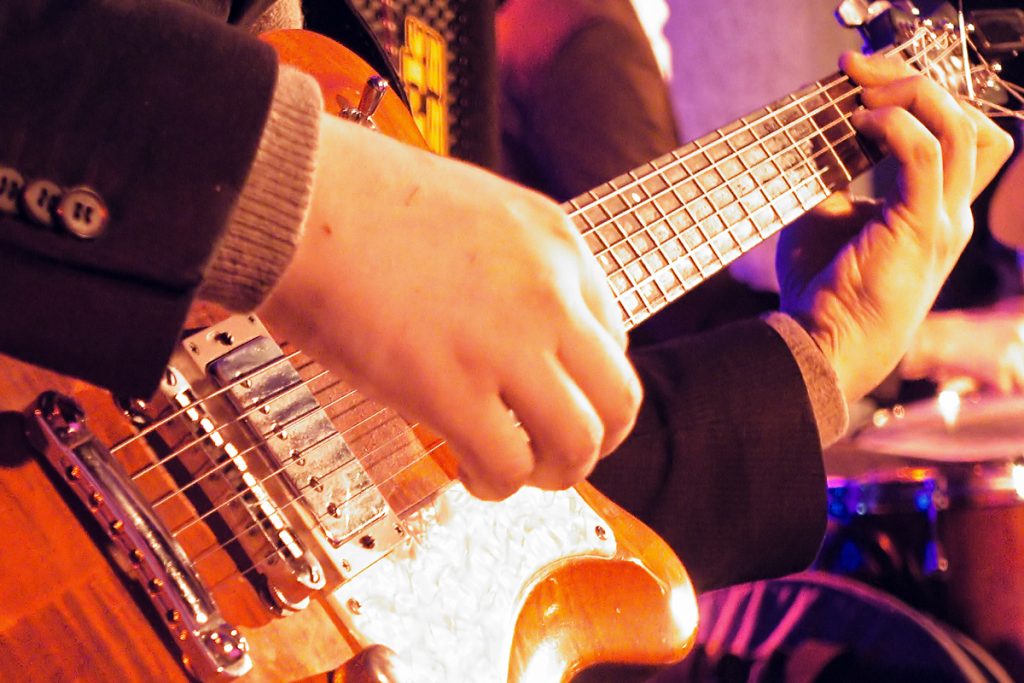Most guitar players are familiar with the pentatonic scale; often times it’s the first scale you learn to play on the guitar. It’s a major part of blues, rock, and country, but many jazz players seem to look past it when developing their bebop vocabulary. However, it’s a great tool to incorporate into your jazz toolbox, adding color, dimension, and texture to traditional jazz improvisation.
In Pentatonic Palettes for Jazz Guitar, a TrueFire course by Sean McGowan, you’ll learn the layout of the pentatonic scale(s) on the fretboard and apply them to your jazz playing, as well as explore exotic scales related to the pentatonic scale that work in a jazz context. These lessons taken from the course will give you a sample of what lies within, demonstrating some of the scales and techniques that Sean demonstrates in the full course. Let’s get started!
Combining Inversions & Sidestepping – Demonstration
Download the tab, notation, and jam track for this pentatonic jazz lesson on TrueFire.
We can utilize our pentatonic substitutions in all the regions of the fretboard by combining different scales and forms, emphasizing various color tones in each region. Another way to create interesting colors, and even some dissonance, is by employing chromatic side-stepping.
Minor 6 Kumoi Scale – Demonstration
Download the tab, notation, and jam track for this pentatonic jazz lesson on TrueFire.
This extremely versatile pentatonic scale will sound great in minor seventh, sixth, and minor-major settings, offering a useful alternative to the more common Dorian and Melodic Minor scales. It also sounds awesome over Jazz Blues and traditional ii-V-I(i) progressions.
Exploring Hirajoshi & More Pentatonics
Download the tab, notation, and jam track for this pentatonic jazz lesson on TrueFire.
There are many different pentatonic scales available to use in improvisation, and another colorful pentatonic that in root position implies a natural minor (Aeolian) sound is the Hirajoshi. It is a fantastic alternative to the Kumoi, and also can be easily applied to more common harmonic settings such as Major7/Lydian#11 chords, m7(b5)/Locrian chords, etc. You’ll be surprised at how much your phrasing is affected by thinking of and employing these pentatonic regions and substitutions, as opposed to modes.
Two Five One Etude: 3 – Demonstration
Download the tab, notation, and jam track for this pentatonic jazz lesson on TrueFire.
This étude explores a ii-V-I-VI turnaround, as well as some Kumoi substitutions for different colors over the V7 and VI7(V7/ii) chords. To keep things simple, we’ll utilize the “chromatic neighborhoods” concept from the previous étude.
Fall Foliage – Overview
Our first performance étude is based on the classic jazz standard, “Autumn Leaves”. This étude will feature several substitution devices we explored using the Minor Pentatonic, Kumoi, and Dominant scales and regions.
Fall Foliage – Performance
Download the tab, notation, and jam track for this pentatonic jazz lesson on TrueFire.
Fall Foliage – Breakdown
Download the tab, notation, and jam track for this pentatonic jazz lesson on TrueFire.
Impress-a-tonic – Overview
This next étude explores a medium-up tempo modal song, moving between D and Eb Dorian tonal centers, and based on the changes to “So What” and “Impressions”. The solo features colorful minor pentatonic substitutions and chromatic side-stepping to create some ‘outside’ sounds.
Impress-a-tonic – Performance
Download the tab, notation, and jam track for this pentatonic jazz lesson on TrueFire.
This next étude explores a medium-up tempo modal song, moving between D and Eb Dorian tonal centers, and based on the changes to “So What” and “Impressions”. The solo features colorful minor pentatonic substitutions and chromatic side-stepping to create some ‘outside’ sounds.
Make sure to head over to TrueFire to get even more pentatonic scale lessons in the rest of the course. As always, each lessons comes with tab, notation, and jam tracks to help you practice on your own. Check it out now!
